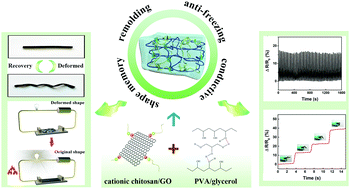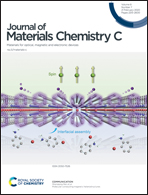Thermo-responsive shape memory sensors based on tough, remolding and anti-freezing hydrogels†
Abstract
Recently, hydrogel-based sensors have been rapidly developed due to their excellent flexibility, stretchability and toughness. However, it is still necessary to develop a hydrogel sensor with shape memory and remolding performance for multi-field applications. Here, a dual physically cross-linked shape memory hydrogel sensor was fabricated via blending poly vinyl alcohol (PVA), cationic chitosan and graphene oxide in water and glycerol. The introduction of cationic chitosan endows the hydrogels with excellent electrical conductivity. Therefore, the hydrogel can be integrated as a strain sensor to repeatedly monitor human motions. Meanwhile, the hydrogel can be used as a thermo-responsive shape memory sensor by virtue of orientation of PVA molecular chains under force and disorientation after heating. Besides, the hydrogel possesses anti-freezing properties with mechanical flexibility at −20 °C. Due to the dual physical cross-linking, the hydrogels can effectively dissipate energy and reconstruct the network; thus, the hydrogels gain excellent strength and remolding properties. In a word, this strategy provides a feasible method to prepare multifunctional shape memory hydrogels applied as wearable strain sensors and shape memory sensors.



 Please wait while we load your content...
Please wait while we load your content...